AMD’s Radeon HD 5770 & 5750: DirectX 11 for the Mainstream Crowd
by Ryan Smith on October 13, 2009 12:00 AM EST- Posted in
- GPUs
Power, Temperature, & Noise
With the 5700 series being built using TSMC’s 40nm process, and with their low target power, we should see some interesting results here.
We do need to note however that thanks to some badly timed broken hardware, we’re using our secondary test rig for noise and temperature data, so the results are not directly comparable to our 5800 series reviews. As a result we also only have power data for the 5770; we weren’t able to get power data on the 5750 in time for this article.
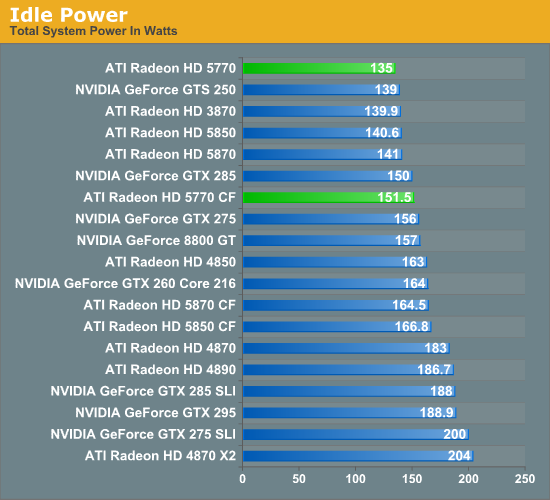
Thanks to the 40nm process and relatively simple nature of Juniper, the 5770 turns in the best idle power usage of all of our mainstream and high-end cards. At 135W it edges out the GTS 250, the 3870, and its bigger brothers the 5800 series. Coupled with a good CPU, and this should result in a system with very good idle power usage for the performance levels it provides.
We can also see the low power usage of an individual 5770 in our 5770 CF usage. There's a 16.5W difference, as the slave card gets to power down even further than 18W.

At 256W for load power, the 5770 isn’t quite the winner here like it is for idle power. The 3870 beats it by 14W at the cost of a significant degree of performance, while the 8800GT is neck-and-neck with the 4770, again with a decent-sized performance gap. Everything past here approaches 300W and beyond. As a result, even if it’s not the least power hungry card we have, it’s very close, and it’s certainly among the best for on a power-to-performance ratio.
Meanwhile looking at the Crossfire results, we see that there's a 134W difference between cards. As the Evergreen architecture allows us to go higher so long as the VRMs are safe, this appears to that situation in action.
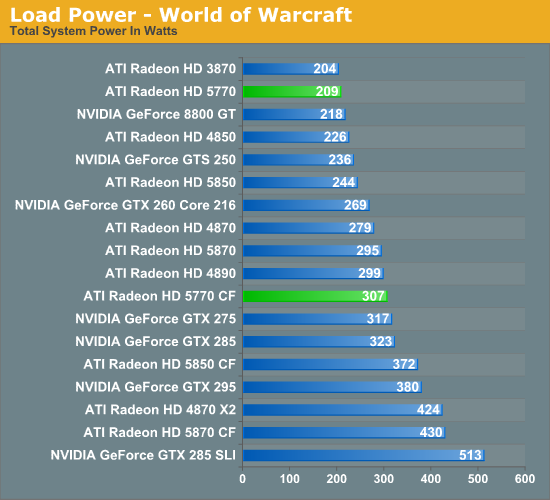
World of Warcraft gives us similar results. The 5770 still doesn’t come out on top, but its bested only by the 3870 and its significantly lower performance. The gap on the other side isn’t particularly large either, but the first card that can beat the 5770’s average gaming performance doesn’t show up until we hit the 5850.
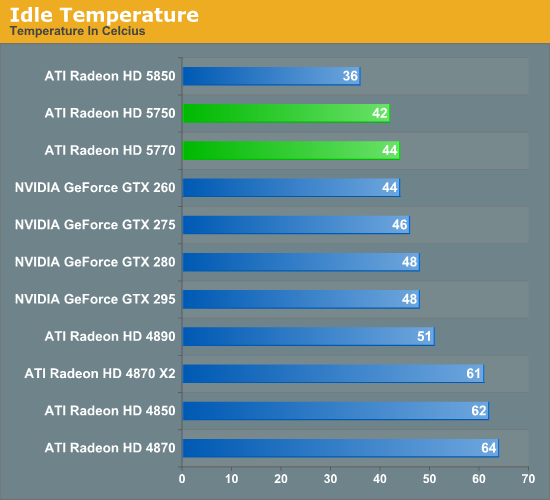
The 5700 series turns in some of our best idle temps, tying or beating everything besides a 5850. In fact we’re a bit surprised to see a 5850 win here given the lower idle power usage of the 5700 series, but the data doesn’t lie.
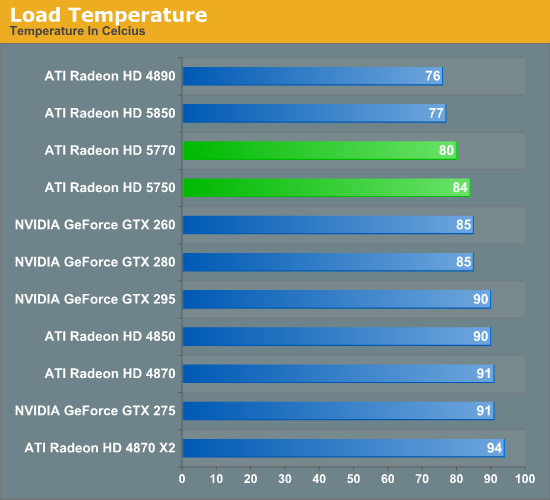
It’s load temperatures where all of the action is at. Again the 5700 series do quite well here, only losing to the 5850 and a very loud 4890. Compared to the rest of the 4800 series in particular, we’re a good 6C-11C cooler for a set of cards that offer similar to slightly less performance. Aren’t smaller manufacturing processes great?
However in spite of the 5750’s lower power consumption, it doesn’t do so well here in terms of temperature compared to the 5770, coming in 4C hotter. We’re going to chalk it up to the egg cooler being unable to match the 5770’s shrouded cooler. This of course makes the fact that the 5770’s shrouded cooler is going to eventually go away all the more meaningful, as conceivably the replacement coolers would end up being less effective.
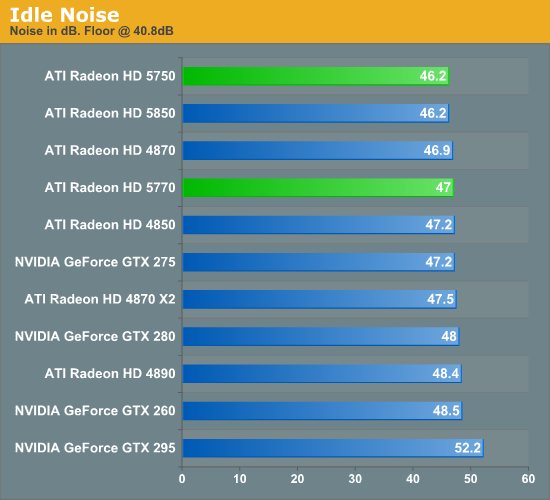
As is the case for most of the cards we test, at idle they’re virtually all the same. The 5700 series are no exception to this rule.
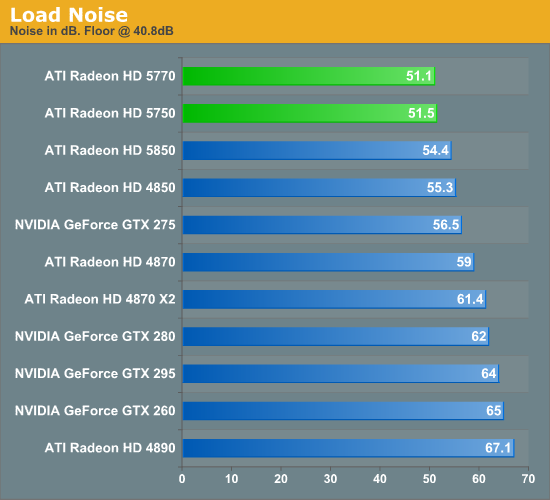
With the low power consumption of the 5700 series, their coolers don’t have to work very hard to reach their already low load temperatures. At 51dB, these are the quietest cards we’ve tested at this level of performance; we would need to drop down to something slower yet (like yesterday’s GT 220) to find something quieter.
We also can’t rule out the possibility of the 5750 going passive in the future, given its already dainty cooler. We’ve seen it done before on an 8800GT, which has a similar thermal envelope. This certainly has all the makings of the fastest passively cooled card on the market, if someone can build the right cooler.
This also leaves the door open to the idea of using the 5750 as an HTPC card. With bitstreaming audio support it’s the best HTPC card we’ve tested yet from a features standpoint, but we’re not convinced that it’s going to be the best thing out there given it’s >$100 price tag and the fact that it’s still power-hungry enough to need a PCIe power connector. In the long-term the 5600 series may be a better replacement given the same features and lower power consumption that a lower-performing part will offer, but that’s something we won’t be able to test until next year.










117 Comments
View All Comments
Spoelie - Tuesday, October 13, 2009 - link
The difference is obviously the memory bandwidth. It seems to me that ATi should have gone with a 192bit bus, this change alone would have made the HD57x0 a worthy successor to the HD48x0 range, without any performance caveats, while still being significantly cheaper to manufacture (40nm vs 55nm, 192bit vs 256bit).Skiprudder - Tuesday, October 13, 2009 - link
I'm guessing your right, but I'd like to see Anand (or Ryan) do one of the track-down-the-engineers that this site is famous for, and hear the rational on AMD's part.CarrellK - Wednesday, October 14, 2009 - link
Anand knows where I live...CarrellK
futrtrubl - Tuesday, October 13, 2009 - link
Or even just overclock the memory and see how performance scales. That would provide some evidence for the memory bottleneck theory.plague911 - Tuesday, October 13, 2009 - link
At this price point it looks like the 5770 & 5750 are priced to pad AMD's pockets, not to provide increase performance (not that, that's a bad thing when in a war with Intel). With the smaller process size and smaller chip size and similar performance each new part sold will net AMD a substantialy higher profit. This is why AMD will likely kill off the older gen instead of droping the price point.MadMan007 - Tuesday, October 13, 2009 - link
Yes I think that's where my mild disappointment comes from. Not that they aren't great cards for the launch MSRP, they just aren't great in light of street prices, but unlike HD4800 or even arguably HD5800 AMD doesn't seem interesting in shifting the price/performance curve with these cards. At best matching the current price/performance curve leaves me a bit cold.MonkeyPaw - Tuesday, October 13, 2009 - link
That's been the trend from ATI lately with their mid-grade cards. The 5700 series is meant to offer roughly the same performance of the 4800 series for a cheaper price. The 4600 series last time was meant to match the 3800 series (the 4770 was quite an oddball though). It's not a bad system, really, as it allows ATI to migrate their lineup with some consistency.Lonyo - Tuesday, October 13, 2009 - link
It might be that some of the cost does indeed come from the RAM though.Once GDDR5 chips drop some more, it will be easy for AMD to drop the prices on these cards, but that might (might) be what's limiting pricing options.
Or AMD just want to try and get maximum profit from these cards.
But even so, when GDDR5 prices drop it will be easier to extract profit at lower prices, so GDDR5 pricing will still be at least partly responsible.
geok1ng - Tuesday, October 13, 2009 - link
Reading the charts it gets obvious that it is upgrade time: lets get 4850s, 4870s, and even 4850X2-4870X2 on the next weeks before these cards phase out: they are faster and a LOT cheaper than the 57xx series. As for the high end consumers, just wait for the 5870X2, now that is a card to roll eyes, when and IF it launches.codedivine - Tuesday, October 13, 2009 - link
This is relevant only for compute folks like me, but does 57xx support double precision?